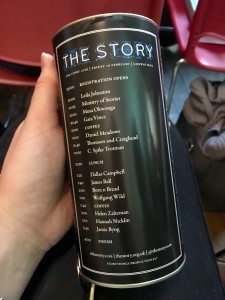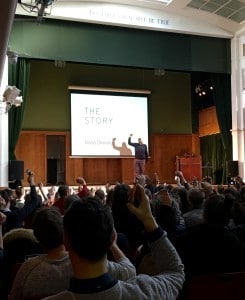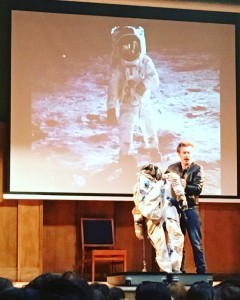I was lucky enough to attend The Story last Friday and it got me thinking. What makes a good story?
The one-day event is “a celebration of everything that is wonderful, inspiring and awesome about stories” (how to tell them, what makes a good one, how they engage an audience). It also includes people telling stories. For example, we heard an exploration of man’s journey into the anthropocene – an epoch we’re rapidly approaching where humans are beginning to have a major impact on the Earth and our environment.
Both the theme of the day and the presentations themselves made me ponder the nature of a successful story. As with all conferences, some speakers were excellent, others were less sure-footed. Yet, it’s always hard to tell which sessions will be your favourite when you read the agenda (in this case, ingeniously printed on a tin of biscuits).
It occurred to me that an interesting topic, or idea, isn’t always enough. It needs to be well-executed to drive real audience engagement. The best speakers / storytellers had several things in common, all of which are elements that apply to telling a good brand or marketing story:
For example, Daniel Meadows, a photographer and documentarist used polygraph photos, audio, video and imagery to take the audience on a journey through his life story and his most famous work. This included his 1973-74 travels around England in a double decker bus where he covered 10,000 miles and took 958 portraits of real people in their homes (complete with AMAZINGLY retro wallpaper).
He conveyed a lifetime of storytelling through a simple structure – a summary of his parent’s marriage (on the homepage here), his childhood, his career highs and the recent acquisition of his work by a museum. He concluded by highlighting the power of stories to change perceptions and did it with a large dose of humour – always a crowd pleaser. The response was an almost rock-star reception with applause that lasted several minutes. Now that’s audience engagement!
 Musa Okwonga, a poet, journalist and musician, used very similar techniques. He spoke about the stifling of journalism, and the often brutal reaction he receives via social media – the full script is here. He began by summarising what the presentation would cover, handed out a free coffee to the crowd (not necessarily crucial to marketing campaigns but it doesn’t hurt!) and led the audience in a rousing ‘social media prayer’ with iPhones held high:
Musa Okwonga, a poet, journalist and musician, used very similar techniques. He spoke about the stifling of journalism, and the often brutal reaction he receives via social media – the full script is here. He began by summarising what the presentation would cover, handed out a free coffee to the crowd (not necessarily crucial to marketing campaigns but it doesn’t hurt!) and led the audience in a rousing ‘social media prayer’ with iPhones held high:
“Our Father who art in Windows 7, hallowed be thy name…..
….. For thine is the kingdom, rapidly decreasing battery power, forever and ever. Amen.”
Again, he took us on the journey of his career and social media battles and concluded with an impassioned speech on why progressive media platforms need to be better funded – “we need to see journalists as an essential public good.”
Dallas Campbell, meanwhile, told a story close to any sci-fi geek's heart (just me?), about how the Russian’s engineered the first spacesuit. As he’s currently working on a documentary about the same topic, he bought a show and tell piece – a real life cosmonaut suit (*fan girl scream*).
The presentation had a clear structure, beginning with the simple question, what do you want to be when you grow up? His answer: astronaut. He continued by showing the famous photo of Buzz Aldrin on the moon and explained the story of the suit's design and creation in detail (tailored by a group of women in an American underwear factory – who knew?!).
Towards the end of the day, Wolfgang Wild talked us through his life-changing idea – Retronaut (@theretronaut). Wild started the Twitter feed and website, now part of Mashable, in 2010 to curate and share surprising, colour historical photos. The aim was to show “the past like you wouldn’t believe”. He sees Retronaut as something akin to a time-machine (to paraphrase this interview). The photos make you feel like you’re looking at photoshopped images or modern photographs taken in the past. The concept has been incredibly successful amassing 110k Twitter followers and is soon to be turned into a series of books and a TV programme.
Wild explained how he tells a compelling, highly shareable story via images – a discipline that is increasing in B2B marketing, choosing photos based on the following criteria:
The Ministry of Stories, a writing and mentoring centre for kids in east London left me with perhaps my biggest take-away of the day. Children aren’t afraid to be creative and are well-versed in narrative structure, having been immersed in stories their whole lives. We could all take a little bit of inspiration from this instinctive approach to storytelling.
After all, great storytelling isn’t just about enthusiasm (as I hope I’ve demonstrated), or even your objectives, key narrative points, structure, or medium. It’s a combination of all of these things. Consider this next time you are telling a story and you’ll all live happily ever after…
Head Office
Moore House
13 Black Lion Street
Brighton
United Kingdom
BN1 1ND
London Office
24/25 The Shard
32 London Bridge Street
London
United Kingdom
SE1 9SG
+44 (0) 1273 716 820
[email protected]
Head Office
Moore House
13 Black Lion Street
Brighton
United Kingdom
BN1 1ND
London Office
24/25 The Shard
32 London Bridge Street
London
United Kingdom
SE1 9SG